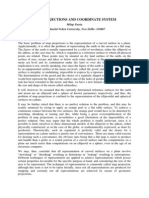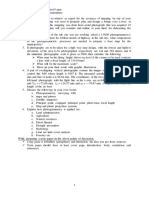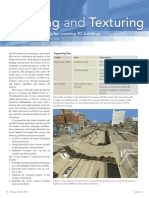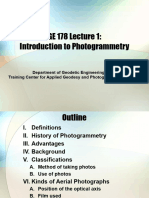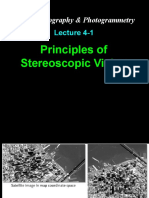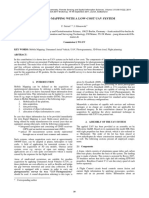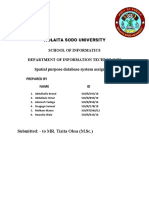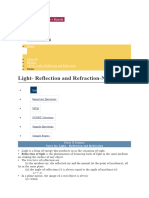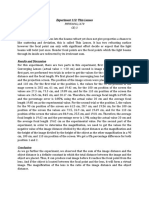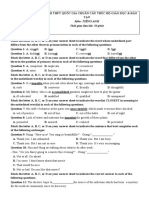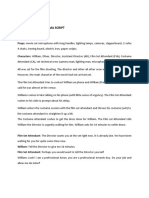Photographic Sensors Objective
This unit is devoted to introducing students to
Part 1 photographic sensors and processes:
Aerial • Part 1 – Aerial Cameras
Cameras • Part 2 – Films and Filters
• Part 3 – Geometry of the Vertical Aerial Photo
• Part 4 – Mission Planning
Introduction to Remote Sensing
GEOG 3110/3115
David Maxwell
Use by permission from Dr. James Campbell Use by permission from Dr. James Campbell
Photographic Imagery Photographic System
Photographic imagery is being replaced by digital imagery,
BUT it will continue to play an important role because …
Image archives represent historical coverage
Underlying principals for photographic systems are
significant for other sensor systems
Photos are used to display imagery from both
photographic and digital imaging systems
Aerial cameras form part of a system that integrated
aerial observations with the broader realm of
geospatial data, including GIS, GPS, & INS.
Use by permission from Dr. James Campbell Use by permission from Dr. James Campbell
Aerial Cameras Part 1
Components
Divided into 3 parts: 1. Lens
B
drive mechanism
1. Components
p 2. Film Magazine
g Vacuum
A
2. Optical Function
2
3. Camera Body
4
3. Types of Cameras
4. Viewfinder
Light intensity
Spherical Aberration
- imperfections in the lens 1 3
C time
Lens Cone
Use by permission from Dr. James Campbell Use by permission from Dr. James Campbell
1
� Simple Lens Compound Lens
Field Stop Mask
Non-parallel Field of view • Compound lenses correct for optical errors
curved surfaces Size of Image
• These are complex and expensive components
• BUT very high quality
Control intensity
of light
Use by permission from Dr. James Campbell Use by permission from Dr. James Campbell
Film Magazine Camera Body
• Holds other
• Holds film supply, components
and take-up spools together in correct
relationships
• Permits convenient, • Maintains
in-flight change of orientation of
film optical system with
respect to terrain
Use by permission from Dr. James Campbell Use by permission from Dr. James Campbell
Part 2
Viewfinder
Optical Function
The camera operator can …
• Refraction - spherical aberration
View the terrain as it
passes beneath
be eat the
t e
• Chromatic Aberration
aircraft
Start/stop acquisition of • Diaphragm Aperture
aerial photographs as
landmarks appear • Relative Aperture
Use by permission from Dr. James Campbell Use by permission from Dr. James Campbell
2
� Refraction Optical Characteristics of Lens Chromatic Aberration
Refractive index of the glass Focal point is not identical for all wave lengths
Degree of curvature present in
the lens
Common
Quality of the lens determined focal Point
by quality of glass
Precision with which that Glass is
shaped
Accuracy at which it is Positioned Focal lengths will vary with wavelength
within the camera Different wavelengths within the spectrum will be
brought to focal points at differing distances from
Spherical aberration – imperfection
the center of the lens, creating a blurring, or mis-
In the lens cause image distortion,
Image clarity loss registration of colors within an image.
Use by permission from Dr. James Campbell Use by permission from Dr. James Campbell
Relative Aperture
Diaphragm Aperture Specification of aperture size … independent of camera size
A system of sliding metal plates permits convenient control of
the size of the camera aperture using a simple instrument.
Standard apertures:
f1, f1.4, f2, f2.8, f4, f5.6, f8, f11, f16, f22, f32, f64, . . . Adjustable opening to that admits light
Controls the intensity of light at the focal plane
50%
Relative aperture: f = focal length / aperture size
Controls the brightness of the image NOT the size By a factor of 2
size is controlled by the field stop mask
Large f number: aperture is small relative to focal length
Use by permission from Dr. James Campbell Use by permission from Dr. James Campbell
High quality Aerial cameras
Vignetting Shutter – controls the length of time that
the film is exposed to light
FILTERS might be need or not Film magazine – light tight container that
holds the supply of film
Lens cone – supports
pp lens and filters and holds
them in their correct positions in
relation to the film
Drive mechanism – advances the film after each
exposure, using electric motors
activated in coordination with the
shutter and the motion of the plane
Aerial cameras with wide field of view – result in light reaching
Image motion compensation or forward motion compensation
the edges of the field of view are typically dimmer than
3
� Part 3
Types of Cameras Panoramic Camera
• Aerial cameras exist
in many forms • Prism or lens scans
from horizon to
• Each camera is horizon as the
designed for a aircraft moves
specific
ifi ffunction
ti f
forwardd
• Each frame is an
elongated strip
Three Camera types: oriented across the
1. Cartographic Camera axis of the flight
line
2. Panoramic Camera
3. Strip Camera
Use by permission from Dr. James Campbell Use by permission from Dr. James Campbell
Panoramic Photography Strip Camera
Drive system pulls film past the slit at a speed that
compensates for the apparent motion of the ground
flight path beneath the aircraft. (adjusted for speed and altitude of aircraft)
Lacks a conventional
shutter
Acquires sharp
photographs at high
speeds, low attitudes
left right
Geometric Geometric
Distortion Creates a single strip-
Distortion
like frame
Credit: U.S. Forest Service
center
Suitable for detailed interpretation
Use by permission from Dr. James Campbell Use by permission from Dr. James Campbell
Strip Camera
Aircraft Aerial Camera
McDonnell RF-101C
Credit: US Air Force
Credit: US Air Force
Credit: CIA
Credit: CIA
Use by permission from Dr. James Campbell Use by permission from Dr. James Campbell
4
� Aerial Camera …
Part 4
Annotation
Film Annotation
Advanced cameras provide the capability for more
detailed annotation using in‐flight data.
Common annotation found on each frame:
• Date (12-15-58),
• Project designation (CQJ),
• Roll number (1W), and
• Frame number (89).
• Additional information sometimes provided
Use by permission from Dr. James Campbell Use by permission from Dr. James Campbell
Use by permission from Dr. James Campbell





